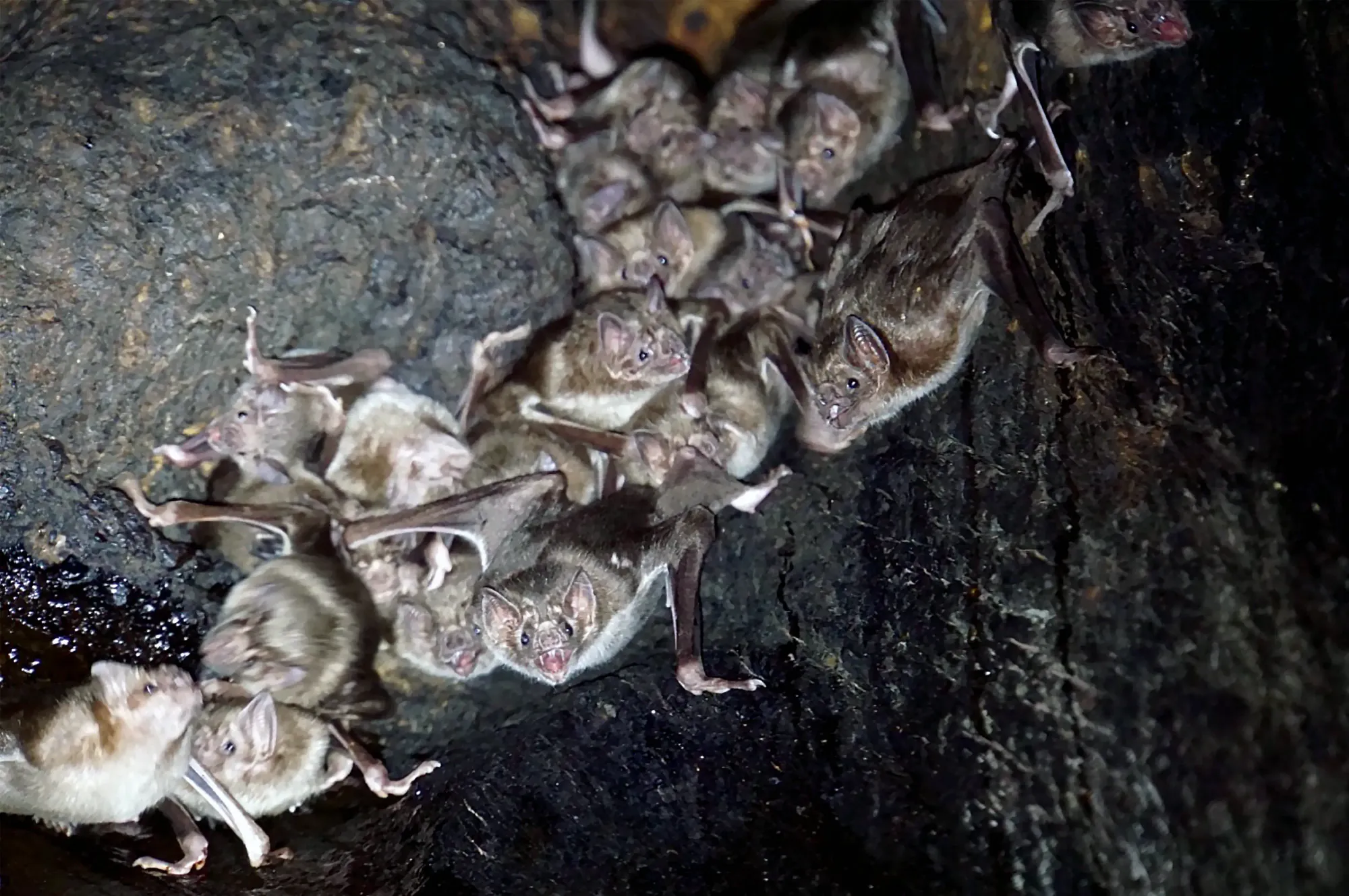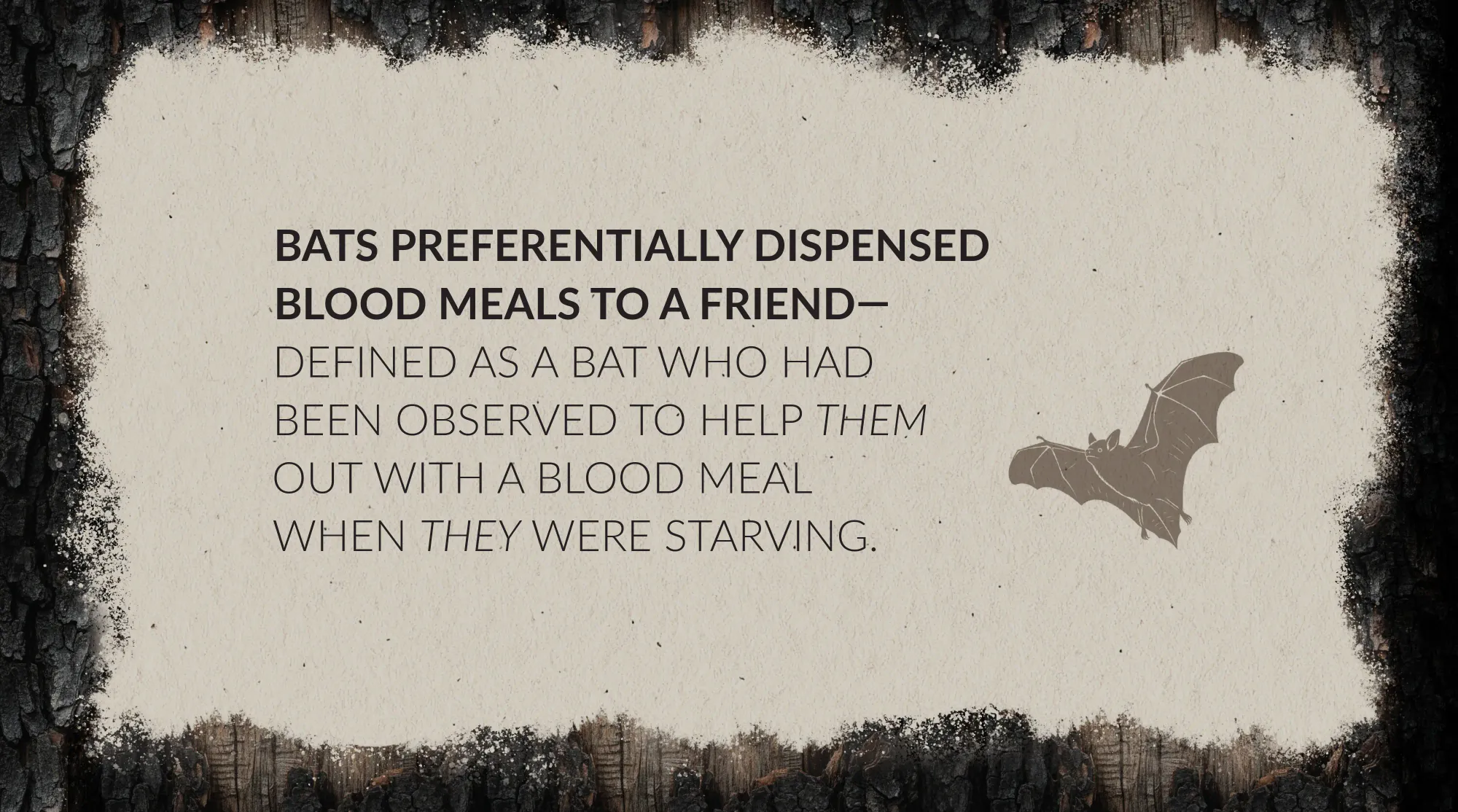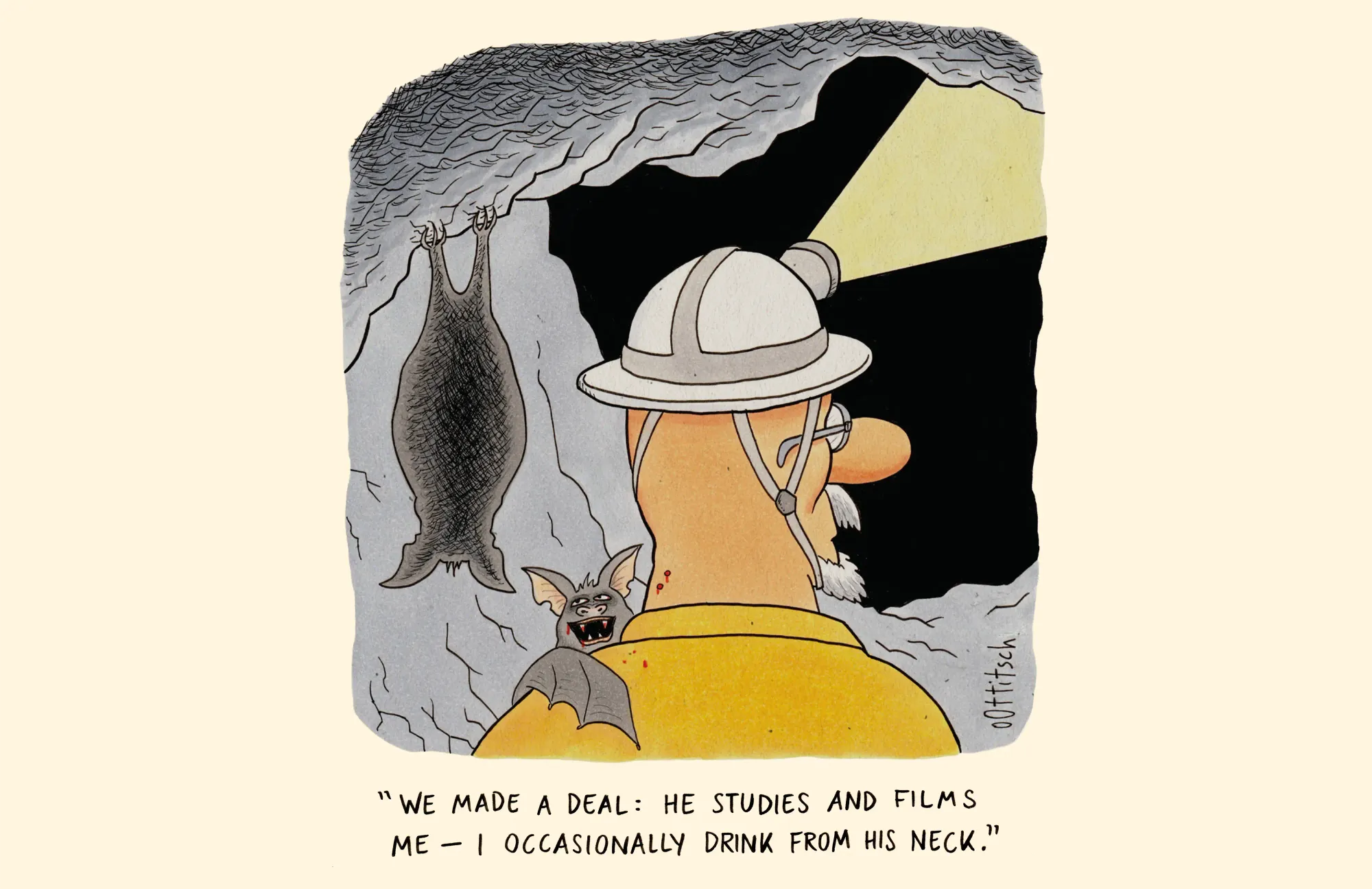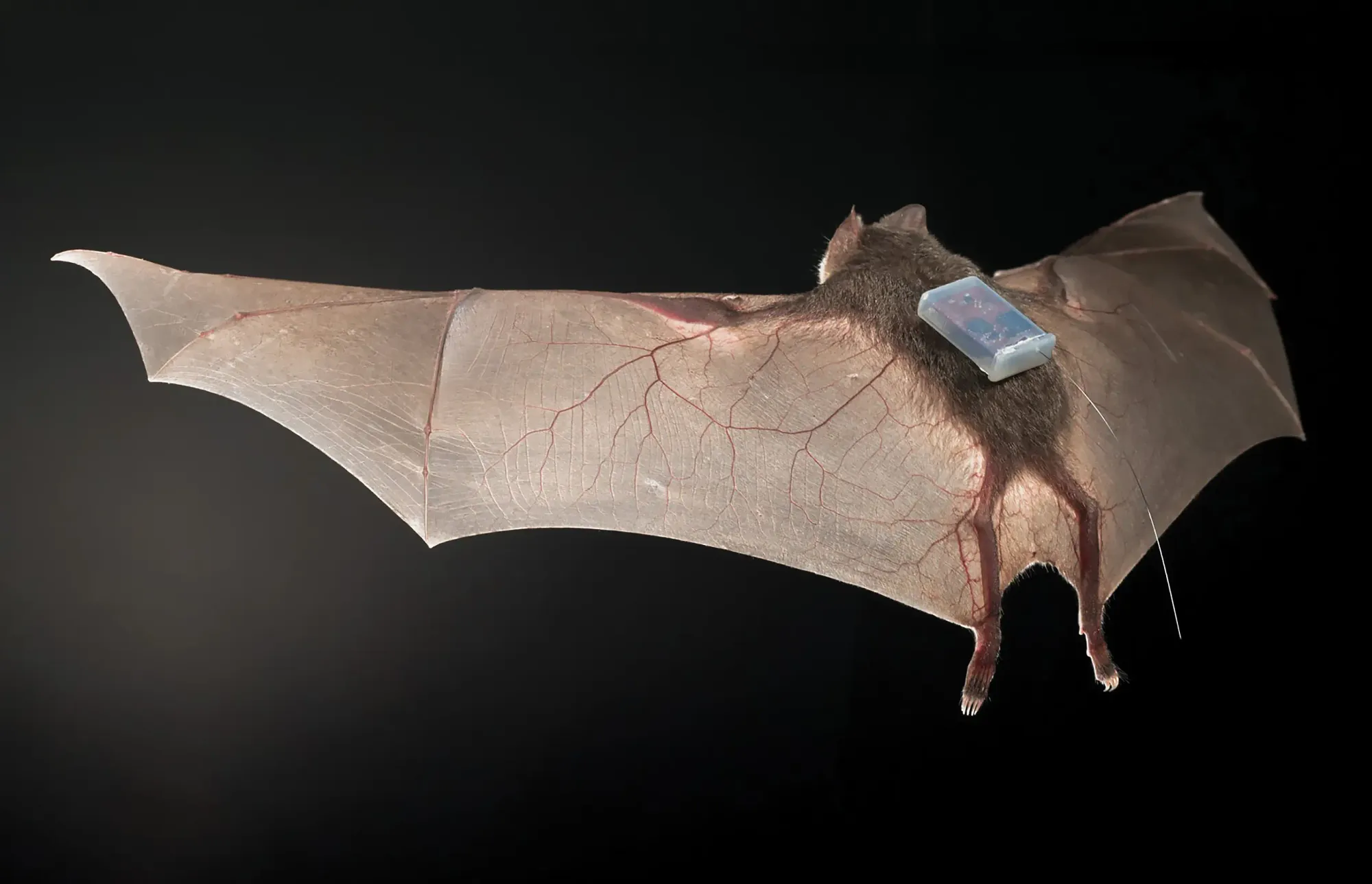Friendships Written in Blood [Meals]
![Friendships Written in Blood [Meals]](/content/images/size/w2000/2025/10/vampire-with-bats-on-steak.webp)
Before telling the tale of a classic friendship in nonhumans, I need to bust a myth about Dracula (Romanian for devil). In Bram Stoker’s classic horror tale, Count Dracula is a vampire, and when he’s in human form he can and does suck human blood. He’s also a shapeshifter who takes on many forms, including that of a bat. But Dracula does not transform into a vampire bat and suck blood when he’s in his chiropteran form. That transformation into a blood-sucking vampire bat only happens much later when the movies come out. Still, virtually everyone associates the Count with a vampire bat (Desmodus rotus), which has given these poor flying mammals a rather bad rap. Here, I’ll continue the resuscitation of the reputation of these flying mammals that began with the work that my colleagues Jerry Wilkinson, Gerald Carter, and Simon Ripperger have done on vampire bat friendships over the last three and a half decades.

It began in the early 1980s, with Wilkinson’s work on the social behavior of vampire bats inhabiting roosts in northwest Costa Rica. Roosts contain a dozen or so bats, mostly females, and house a mixture of relatives and unrelated individuals (Figure 1). Weighing between 25 and 40 grams each, vampire bats do indeed rely on blood meals, but largely from cattle and other domesticated species (and rarely from humans).

However, vampire bats have a problem above and beyond being joined at the hip with Count Dracula. Flapping through the air requires a lot more energy than moving about on terra firma: so much energy that if a bat doesn’t get a new blood meal every second or third day, it will starve to death. Wilkinson soon came to learn that there are two very different ways for a vampire bat, particularly an especially hungry one, to obtain that life-preserving blood meal: either fly out and clamp onto an unsuspecting cow (or other victim) or beg another bat to regurgitate some of the blood meal in its gut directly into your mouth and hope it obliges, which on occasion it does.
What Wilkinson wanted to know was “on what occasion?” Part of the answer is that a bat was far more likely to solicit and receive a blood meal from a roostmate if it solicited that meal when it was very hungry. Still, many hungry bats were turned away when begging. Why? Were they inclined to share most blood meals with unrelated friends? Relatives? Some combination of the two?
Based on 400 hours of observation, often lying on his back, wearing a headlamp, and looking up at a roost in a hollow tree trunk, Wilkinson found genetic relatives were more likely to swap blood meals with one another than with other individuals, though the average genetic relatedness in a roost was low, and so that alone couldn’t explain the observed patterns of blood sharing. To see whether unrelated friends were helping each other, Wilkinson created an “index of opportunity for reciprocity.” And what he found was that unrelated vampire bats were more likely to give a blood meal to someone with whom they had many interactions in the past. Wilkinson then collected bats from two different locations, separated by 50 kilometers (31 miles), and put them together. He systematically withheld blood from one individual each night, until each individual had been starved twice. Thirteen instances of blood sharing were recorded. All but one involved two bats captured at the same site. More to the point, bats preferentially dispensed blood meals to a friend—defined as a bat who had been observed to help them out with a blood meal when they were starving.

Over the years, and then the decades, a much clearer picture of friendship among vampire bats has emerged. In 2013, together with his student Gerald Carter, Wilkinson set out to gauge the relative importance of friendship, based on the reciprocal exchange of meals versus that based on genetic kinship, in driving blood sharing. Friendship was 8.5 times more important! So blood sharing is more powerful than gene sharing. What’s more, in the very same study, they found that friends who shared blood meals also groomed one another by picking off parasites more than did other pairs of bats. A follow-up experiment many years later found an even deeper connection between grooming and the exchange of blood meals between friends. When unfamiliar female vampire bats were housed together for 15 months, pairs of bats first developed a friendship based on grooming, a relatively low cost behavior. After testing the waters, as Wilkinson and his colleagues describe it, the bats then took friendship to the next level and began the exchange of blood meals.

More and more evidence was mounting that friendship was one rock upon which vampire bat society was built. Subsequent experiments demonstrated that friendly bats who had provided others with meals even years earlier received more overall assistance from roostmates when they themselves were starving, suggesting the construction of an enduring friendship network. What’s more, when a female’s best friend—the bat with whom she had exchanged blood meals most often—was removed to see how she would fare in that challenging situation, further evidence for the existence of a friendship network emerged; females that had more friends fared better when their best friend was removed than did females who had fewer friends.
Simon Ripperger, a student of Carter’s, and so a “grand-student” of Wilkinson’s, wanted to determine whether there was a full-blown friendship network in vampires. Ripperger had experience using automated tracking systems for studying social behavior in bats, and he and his team came up with a next-generation hardware and software package that included sensors that tracked a vampire bat in real time. These sensors, weighing a mere two grams, sent out signals every two seconds and “talked” with one another and with various base stations placed in a bat’s environment. The default setting on a sensor was low-power mode, but when another bat with a sensor was within five meters or so, the sensors on both individuals “woke up” and a “meeting” began. That meeting was over when no signal was picked up for ten seconds. All that information obtained was stored in the sensor’s memory, to be downloaded later (Figure 2). These sensors provided the sort of fine-scale monitoring needed to study social dynamics both when bats were in a roost, as well as when they were out looking for a victim to tap, and so opened the door to studying friendship in a way that was simply not possible otherwise.

Ripperger and his team worked with a colony of vampire bats that Carter had at the Smithsonian Tropical Research Institute (STRI) in Panama. These bats had been captured in Tolé, about 700 kilometers (435 miles) northeast of STRI, in an area replete with cattle pastures that provided vampire bats with many meal targets. The plan was to keep the bats at the STRI for around two years total and then release them back into the tree in Tolé from which they were captured, but this time they’d be wearing the talking sensors on their backs.
While the bats were at the STRI they were periodically starved, and researchers noted which, if any, other bats regurgitated a blood meal to its starving roostmate. An analysis of the food-sharing and friendship social network at the STRI found that the amount of food a starving bat received from a groupmate was predicted by the amount of food the bat had given that individual when it was hungry. In addition, the amount of grooming bat 1 had received from bat 2 also predicted the chances that bat 1 would feed bat 2 when bat 2 was hungry. Next, twenty-three bats from the STRI, sensors on their backs, were brought back to their home tree in Tolé and released. The same day, a control group of twenty-three other bats from that same tree were captured and fitted with talking sensors.

Back in their home tree, the STRI-released bats tended to roost together rather than with the control bats. What’s more, the food-sharing and grooming networks the bats had built when they lived at the STRI predicted how much time they spent near each other in the roost at the tree in Tolé. It was clear that vampire bats were embedded in friendship and bloodsharing networks in their roost in the wild. Still, the blood that bats were sharing (or not) was lapped up far from the roost, and no one, including Ripperger and Carter, had any idea whether the network dynamics at the roost affected the vampire bats when they were out at night foraging. The talking sensors, however, now made it possible to gather just such data.
To track the bats from the time they left their roost to when they reached the area near the cattle they targeted was no easy matter, and required, among other things, positioning a series of receivers, powered by car batteries. When the glitches were ironed out, Ripperger and Carter found that the food-sharing and friendship social network among bats at the roost predicted which bats met up when they were out foraging. What’s more, these interactions outside the roost really were “meetups,” not just cases where bats leaving the roost together stayed together. Vampire bats left the roost individually, not in pairs. They also came back to the roost alone. But when they were out foraging, they would meet up for interludes, some short, and others lasting up to thirty minutes (Figure 3).

Proximity sensors could only detect distance between bats, not their behavior per se, but there is some evidence that meetups were associated with clamping onto a cow in a field while a friend also did so. Ripperger and his group made audio recordings of some of the bats who were out in the field looking for cows, and found that meetups are initiated by a vocalization that vampire bats had been recorded to emit when they are trying to locate friends inside the roost.
Friendships—sometimes life-saving friendships—formed within a roost extended far beyond that roost. Blood “oaths” among vampire bats are not deadly, but “lifely” serious.
Further Reading
- Carter, G.G., Farine, D.R., & Wilkinson, G.S. (2017). Social Bet-Hedging in Vampire Bats. Biology Letters 13, DOI:10.1098/rsbl.2017.0112
- Carter, G.G., Farine, D.R., Crisp, R.J., Vrtilek, J.K., Ripperger, S.P., & Page, R.A. (2020). Development of New Food-Sharing Relationships in Vampire Bats. Current Biology 30, DOI:10.1016/j.cub.2020.01.055
- Carter, G.G., & Wilkinson, G.S. (2013). Food Sharing in Vampire Bats: Reciprocal Help Predicts Donations More Than Relatedness or Harassment. Proceedings of the Royal Society 280, DOI:10.1098/rspb.2012.2573
- Carter, G.G., & Wilkinson, G.S. (2015). Social Benefits of Non-Kin Food Sharing by Female Vampire Bats. Proceedings of the Royal Society 282, DOI:10.1098/rspb.2015.2524
- Ripperger, S.P., & Carter, G.G. (2021). Social Foraging in Vampire Bats Is Predicted by Long-Term Cooperative Relationships. PLoS Biology 19, DOI:10.1371/journal.pbio.3001366.
- Ripperger, S.P., Carter, G.G., Duda, N., Koelpin, A., Cassens, B., Kapitza, R., Josic, D., Berrío-Martínez, J., Page, R.A., & Mayer, F. (2019). Vampire Bats That Cooperate in the Lab Maintain Their Social Networks in the Wild. Current Biology 29: 4139–4144.
- Wilkinson, G.S. (1984). Reciprocal Food Sharing in the Vampire Bat. Nature 308: 181–184.